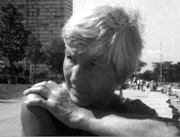The panning shot of an anonymous city street establishes the tensile, yet integral relationship between citizen and environment in Guy Debord’s dense and minimalist essay On the Passage of a Few Persons Through a Rather Brief Unity of Time, describing the rows of generic apartment buildings as places of refuge from the constant social immersion […]
Category: Independent Filmmaking
Sink or Swim, 1990
Composed of twenty-six distinctive chapters, each thematic, one word title representing a letter of the alphabet in reverse order, Sink or Swim is, in some ways, an autobiographical corollary to Su Friedrich’s The Ties That Bind, a series of allusive, poetic, and insightful third person anecdotes that deconstruct the complicated relationship between a girl – […]
The Ties that Bind, 1985
In an interview with Scott MacDonald for A Critical Cinema 2, Su Friedrich comments that the inspiration for her first feature film arose from the idea of her mother’s seeming uprootedness despite having settled in the United States since after the war. This sentiment of an elusive home suffuses her mother, Lore Bucher Friedrich’s candid, […]
Program 7: Nina Fonoroff
The Accursed Mazurka, 1994 A series of stark, alienating, and desolate expressionistic images convey a sense of foreboding and dread as a scratched, narrative soundtrack (reminiscent of an early generation, low fidelity audio broadcast recording) presents an anonymous, paranoiac woman’s curious hypothesis that the onset of her psychological break from reality had been triggered by […]
Animated Passions: The Films of Ursula Ferrara
During the Q&A for the screening of Animated Passions: The Films of Ursula Ferrara, Ferrara commented that her body of work reflects the conventional progression of her formal art school training, graduating from monochrome to color, simple sketches to more complex forms. The theme of evolution and transformation is also integrally connected to the metaphorical […]
Go Go Tales, 2007
During the Q&A for Go Go Tales, native New Yorker Abel Ferrara indicated that although the film’s main setting, Ray Ruby’s Paradise Lounge looks like something straight out of the city’s seedier sections, the authentically gaudy look of the cabaret was actually inspired by an interchangeable array of fly-by-night strip clubs that used to operate […]





